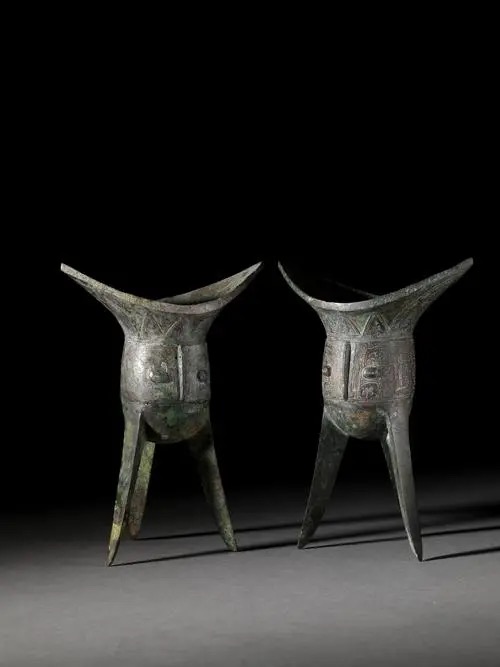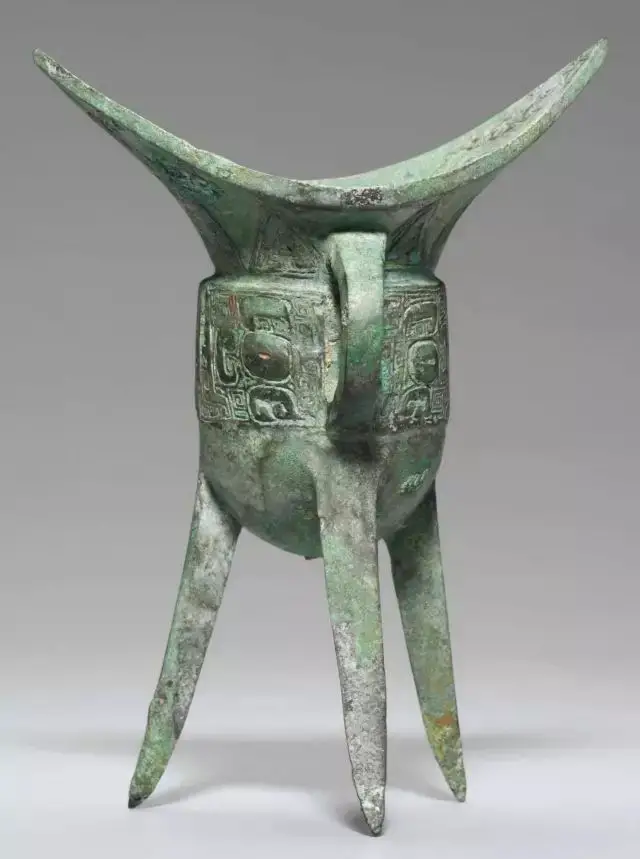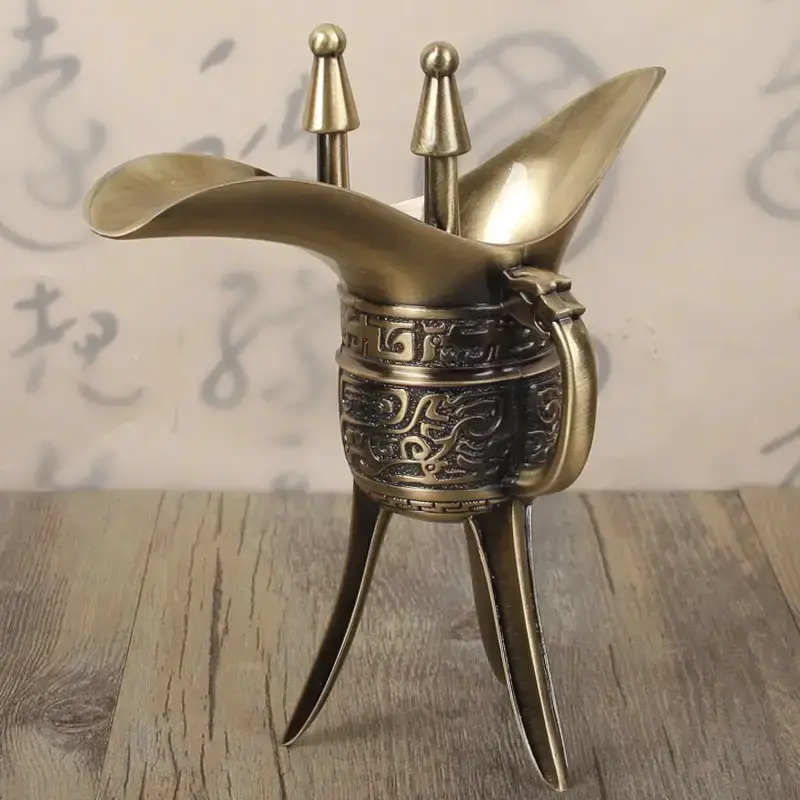“Jiao” is an ancient Chinese wine vessel that originated and developed during the pre-Qin period, used for pouring and serving wine. Similar in form to a “Jue,” it lacks a pouring spout and a column. Initially a common wine-serving vessel, it was intended for use by lower-ranking nobility. The excavation and preservation of “Jiao” artifacts are much rarer compared to “Jue,” evolving into exquisitely crafted ceremonial vessels around the end of the Shang Dynasty and flourishing until the mid-Zhou period before gradually declining.
Derived from the “Jue,” “Jiao” emerged as a new type of wine vessel, appearing abundantly in the late Shang Dynasty or around the transition to the Zhou Dynasty. “Li Ji – Li Qi” states, “In ancestral temple sacrifices, the esteemed raise ‘Zhi,’ while the humble raise ‘Jiao’.” According to “Kao Gong Ji – Zi Ren,” citing the “Han Shi,” it says, “One sheng is called ‘Jue,’ two shengs are called ‘Gu,’ three shengs are called ‘Shao,’ four shengs are called ‘Jiao,’ and five shengs are called ‘San.'” In archaeological findings, wine vessels excavated from tombs mostly consist of a combination of “Gu” and “Jue.” However, sometimes “Jiao” is used instead of “Jue.” For example, tomb No.160 in Anyang Yin Ruins has ten “Gu” matched with ten “Jiao.” Similar phenomena are observed in large tombs around the transition from the Shang to Zhou period in Luoyi, Henan.
Although “Jiao” serves the same purpose as “Jue,” its quantity is significantly less. Rare variations, such as the lidded “Jiao” like the Chenzhao Ning Jiao, are even scarcer. In modern discussions, “Jiao” is a conventional term coined by Song Dynasty epigraphers for a “Jue” shape with no spout but with two wings resembling tails, with a capacity similar to that of “Jue.”

In ancient China, “Jiao” was a common drinking vessel, alongside “Jue,” “Shang,” “Bei,” and other wine vessels. Shaped similarly to a “Jue” but without a column, “Jiao” had symmetric tails with a lid and was used for warming and serving wine. Typically made of bronze or jade, “Jiao” sometimes featured pottery or wooden variations.
The shape of “Jiao” resembles modern cups but is relatively flatter, lacking handles like modern cups. Usually, “Jiao” has three feet at the bottom, resembling the feet of a “Jue,” providing stability on a flat surface. The lid of “Jiao” is peculiar, often curved and can be placed upside down on the mouth of “Jiao,” similar to a modern teacup lid.
In ancient times, when drinking from “Jiao,” it was customary to warm the vessel in a wine heater, enhancing the warmth and aroma of the wine. After finishing the wine in the “Jiao,” other wines could be poured in for continued enjoyment.
Besides its use as a drinking vessel, “Jiao” had other purposes. Sometimes, in ancient banquets or ritual ceremonies, “Jiao” served as a ceremonial item, symbolizing the host’s status and identity. Additionally, “Jiao” could be used as a decoration or art piece, showcasing the owner’s taste and wealth.
Historical Development of “Jiao” Wine Vessel
“Jiao,” evolved from “Jue,” appeared abundantly in the late Shang Dynasty or around the transition to the Zhou Dynasty. While both were wine vessels, they differed in usage; “Jiao” primarily appeared in banquets and daily drinking, considered a lower-level vessel. On the other hand, “Jue” had a more dignified role, used in ritual ceremonies. “Li Ji – Nei Ze” records, “When starting to wear a black robe, from the princes downwards, the robe could be worn out, but the cap and lappets should not be worn out. A black cap, black cap and lappets, a yellow robe, a yellow lower garment, and the rest, the honored ones cross the mats while the inferiors lift up the ‘Zhi’ vessels or ‘Jiao’ vessels.” This indicates that, in ceremonial occasions, “Zhi” vessels were raised by the esteemed while “Jiao” vessels were raised by those of lower status.
During the Han Dynasty, the use of “Jiao” gradually decreased until it disappeared. Although “Jiao” ceased to be used as a wine vessel after the Han Dynasty, it remained treasured as a cultural heritage, valued and passed down through the ages.
Construction of the “Jiao” Wine Vessel
The “Jiao” wine vessel is an ancient Chinese wine vessel, derived from the “Jue,” mainly used for drinking wine. It has a relatively simple construction, consisting mainly of the body, the cover, and the base.
The body is the primary part of the “Jiao” wine vessel, usually oval or elongated. Inside the body, there is a raised ridge dividing it into two sections known as “Dou” and “Sheng.” “Dou” is the smaller part used for holding wine, while “Sheng” is the larger part for more wine capacity. The body has symmetrical ears on both sides, shaped like bird wings, used for holding or hanging.

The cover is the top part of the “Jiao” wine vessel, typically circular or oval. The cover has a central raised ridge dividing it into two sections known as “Niu” and “Wu.” “Niu” is the smaller part for lifting or hanging the cover, while “Wu” is the larger part covering the body. Along the edge of the cover, there are usually several small holes for string suspension or decoration.
The base is the bottom part of the “Jiao” wine vessel, typically with three feet. These feet, shaped like bird claws, provide stability when placing the “Jiao” on a table. The base connects with the body, creating a visually stable appearance.
In addition to these primary parts, the “Jiao” wine vessel may have additional components such as handles, cover hooks, etc. Handles facilitate easy gripping of the body, while cover hooks can be used for hanging or securing the cover. These additional components enhance the practicality and aesthetics of the “Jiao” wine vessel.
Differences Between “Jiao” and “Jue”
“Jiao” and “Jue” are both ancient Chinese wine vessels, and they exhibit some clear differences.
Firstly, in terms of appearance, both “Jiao” and “Jue” are oval, but “Jiao” is shorter and sturdier, with a relatively simpler shape. In contrast, “Jue” has distinct tails and a pouring spout, presenting a more intricate design. Additionally, “Jiao” lacks a column, while “Jue” has a prominent column.
Secondly, in terms of usage, “Jiao” mainly appeared in banquets and other occasions, serving as a lower-level wine vessel. “Jue,” on the other hand, was primarily used in ritual ceremonies, signifying a more esteemed and formal purpose. “Li Ji – Li Qi” records

, “In ancestral temple sacrifices, the esteemed raise ‘Zhi,’ while the humble raise ‘Jiao’.” This indicates that, in formal occasions like ancestral temple sacrifices, the use of “Jue” was considered more prestigious.
Lastly, concerning capacity, “Jiao” was primarily used for holding and warming wine, with a smaller capacity, usually around one sheng. “Jue,” however, could serve both for holding and drinking wine, featuring a larger capacity, generally around three sheng. Moreover, the tail of “Jue” could act as a handle when warming the wine.
In summary, “Jiao” is an integral part of ancient Chinese wine culture. Through the use of “Jiao,” people enjoyed fine wine, strengthened friendships, and enhanced communication. Additionally, “Jiao” reflected the etiquette, culture, and artistic achievements of ancient society. Although “Jiao” is no longer used as a wine vessel today, it is still widely cherished and preserved as a cultural heritage.